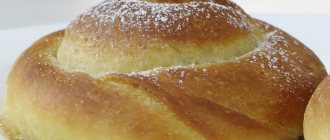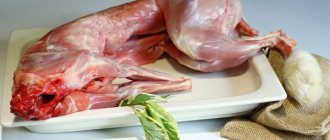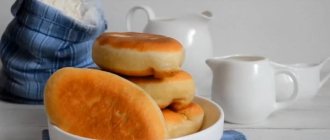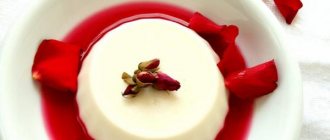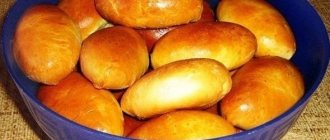Posting in group: Baking
Brioche buns are a French pastry, the first mention of which dates back to the 16th century. A special feature of the recipe is the duration of ripening of the dough, which after kneading is placed in the cold for about 24 hours. Next, it is transferred to a tight mold, where it quickly rises. Thanks to the special “ripening” of the dough, products from it are obtained with an airy texture. The following article presents popular recipes for Brioche buns for cooking at home.
Classic recipe
Brioche buns (a homemade recipe allows you to decorate the product to taste and fluffiness that do not differ from the original) in the basic version can be decorated with any filling.
Preparation next.
What ingredients will you need?
To decorate buns without filling you need:
- butter in a plastic state. The mass fraction of fat in the ingredient must be at least 82% - 250 g;
- flour. The product should be used for baking bread, as it contains the required amount of gluten – 200-250 g;
- live yeast – 8 g;
- cream. The fat content of the ingredient should be from 33% - 50 ml;
- egg. The product should be taken in large sizes and with a shelf life of no more than 5 days - 3 pcs.;
- granulated sugar. Can be replaced with powder - 5-7 g;
- purified water – 25 ml;
- fine salt – 8 g.
You can use powdered sugar to decorate the finished buns. You can prepare any filling to fill the buns.
Step-by-step cooking process
To make the products lush and with a delicate creamy aroma, it is recommended to carry out manipulations according to the following points:
- Products stored in the refrigerator must be removed from it in advance. It is necessary that all ingredients are at room temperature.
- Pour warm purified water into a bowl, add yeast and granulated sugar. Stir the products until they are completely dissolved.
- Then pour flour into a wide bowl with high edges (the product needs to be sifted about 5 times in advance).
- Make a mound of flour with a hole in the center.
- Place eggs, cream, diluted yeast into the flour well; you also need to add salt.
- Mix the flour with the added products until the contents form a lump.
- Next you need to cut the butter into small cubes.
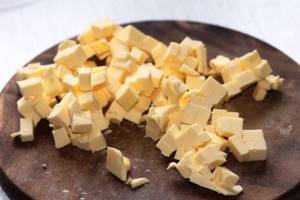
- Give the flour ball the appearance of a small cake and place pieces of butter on the surface of the cake.
- After this, the dough needs to be kneaded for a very long time. The oil should be evenly distributed. On average, this point takes from 15 to 30 minutes.
- After kneading, it is recommended to beat the dough, since large air bubbles in the dough are not welcome.
- Place the dough in a food bag and put it in a cool place. The temperature should be approximately 3-6 degrees Celsius.
- Keep the dough in the “cold” for approximately 18-20 hours.
- After 18-20 hours, the dough needs to be taken out of the cold and allowed to warm up to about 15 degrees.
- Then the dough must be divided into approximately 5-6 parts of the same size, and each part must be formed into balls.
- Place the dough balls into the prepared rimmed pan. High edges are required as the dough will expand during baking.
- Leave the dough in the mold for about 15-20 minutes. During this period of time it is necessary to warm up the oven. Recommended temperature 200-220 degrees.
- After 15-20 minutes, remove the form with the dough into the oven and bake the product for about 15 minutes.
- Then you need to lower the oven heat to 160-170 degrees and bake the buns for about 10-15 minutes. You can determine the readiness of the products by looking at the golden brown crust and using a toothpick.
After cooking, the buns should be cooled in the pan. If you want the products to be glossy, it is recommended to brush them with beaten egg before baking. If gloss is not needed, then immediately after preparing the product you can sprinkle it with powdered sugar.
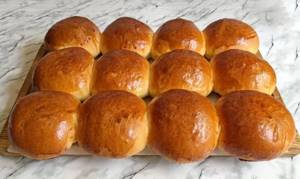
The chosen filling can be added to the cooled bun using a culinary syringe. You can also roll out each ball from 14 points into a small layer, coat it with filling and roll it into a roll. Further, from point 15, the manipulations are similar.
Rules for serving Brioche buns, decoration
It is recommended to serve the bun unassembled. The product can first be poured with melted chocolate, decorated with whipped cream or fresh berries. Brioche can also be served with sweet sauces.
Making Cream Cheese Frosting
Place the softened cream cheese and butter in a mixing bowl and beat with a mixer until light and fluffy. Add powdered sugar and vanilla. Add two tablespoons of milk to loosen the buttercream a little. And keep whisking everything until you reach a fluffy spreadable consistency. Cover the icing with cling film.
Kids Challenge: Let your child put the butter and cheese into a mixing bowl. Then let him add vanilla and milk.
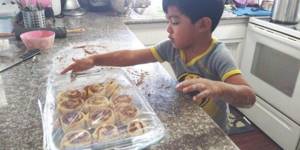
Brioche buns with patissière custard
Brioche buns, the homemade recipe of which can be varied with pâtissière cream, are obtained with an even more delicate taste and texture.
What ingredients will you need?
To make French buns with French cream you will need:
- ready-made dough for Brioche buns (it is better to knead the dough the night before according to the classic recipe) – 900 g;
- milk. Fresh milk should be prepared (shelf life no more than 3 days) with a fat content of 3.2% - 250 ml;
- fresh egg yolk from a large egg - 2 pcs.;
- potato starch – 20 g;
- powdered sugar. You can use powder with added vanilla - 40 g.
To lubricate the product you will need whipped yolk. You can also add 30-50 g of milk chocolate, broken into very small pieces, to the dough.
Step-by-step cooking process
The design scheme for buns when using pre-kneaded dough is as follows:
- Place the yolks, powdered sugar in a bowl and pour in about 30 ml of milk. Mix the ingredients until the powdered sugar dissolves.
- Next, you need to add starch to the resulting yolk mass and mix the ingredients at the same time, otherwise the starch may form lumps.
- Then you need to pour the remaining milk into the saucepan and bring it to a boil.
- Pour the contents from step 3 into the boiling milk and simmer the ingredients with constant stirring until thickened. On average it takes approximately 2 minutes.
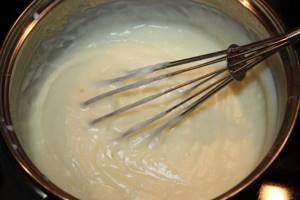
- After the cream thickens, remove the saucepan from the heat and cover it with cling film. The cream must cool completely, otherwise the texture of the buns will be ruined.
- Next, you need to remove the dough from the refrigerator and let it warm up to about 15 degrees.
- Place the dough on a board sprinkled with flour and form it into a sheet. The approximate size of the layer is 30x40 cm.
- Coat the layer with cooled cream; the cream must be distributed evenly, and it should not reach the edges of the dough by approximately 0.7 cm.
- Sprinkle chocolate, broken into small pieces, over the cream. Chocolate can be used as desired.
- Next, you need to carefully roll the dough into a roll.
- Cut the “roll” into pieces. The width of the pieces depends on the height of the container used for baking.
- Then you need to place the pieces of the “roll” into the mold with the cut side up. The distance between the pieces of dough should be left about 1.5 cm. This distance is enough so that the dough can rise during the baking process and the pieces adhere tightly to each other.
- Allow the products to rise. To do this, they need to be covered with film and kept warm for about 40-60 minutes.
- Next, you need to beat the egg and coat the top of each piece of “roll” with it.
- If the entire cut of the “roll” does not fit into the mold, then the remaining pieces can be placed in another mold that is suitable in size. While the buns are baking in the first pan, cover the second pan with cling film and put it in the refrigerator.
- It takes about 30 minutes to bake the Brioche, and the heat in the oven should be approximately 160 degrees.
- Bake the buns in the second pan in the same way. The products must first be given time for the dough to “rise”.
After cooking, the finished buns can be poured with white or chocolate glaze and allowed to cool completely in the mold. The recipe can be simplified. The product can be baked without filling (using the classic method). Once cooled, each bun can be filled with Patissiere cream using a pastry syringe.
How to bake French brioche at home
Brioche is a rich French bread with a lot of butter. It has a special preparation technology: after kneading, the yeast dough is delayed in growth for several hours, as it is placed in the cold. And then, in the form of round buns, squeezed into a form too tight for it, it quickly soars up, turning into an airy, or, as they say in France, “muslin” pastry, all in delicious rosy roundness.
The chief baker of the Baton bakery, Vladimir Shumilin, shared with us the secrets of baking brioche. He revealed all the ins and outs of the French bread, without skipping a single sharp corner or subtle point, with such detail that the brioche will definitely turn out just right even for inexperienced users. At the exit you will find a fluffy crumb, which will come off as airy fibers and disintegrate in your mouth into a thousand melting molecules.
It is believed that brioche was invented in the west of France - in the Vendée, a region famous for its butter. Although it was not quite the same brioche: the dough for it was kneaded with brewer's yeast and braided. Brioches from the Indre and Loire departments in the north-east of the country are considered the benchmark, where entire bakeries specialize exclusively in them and the location of the bakery can be recognized by the mind-blowing smell spreading throughout the area. Finally, there is also a special Parisian brioche: in the form of separate round buns, not stuck together, but crowned with a small bun on the top, such a bun is called “brioche with a head.”
But brioche came into world history thanks to a famous phrase said by Marie Antoinette. When the French peasants were starving and demanded bread, she rashly said: “Then let them eat brioche.” That’s right, it was already in Soviet translations that cakes appeared, since the word “brioche” required too much explanation. Everyone knows how this frivolity turned out for the queen herself, and for France as well.
Although historians believe that Marie Antoinette was not such a fool: the fact is that in lean years, by royal decree, bakers were obliged to sell all bread at a minimum price. So brioche was really sold at the price of ordinary baguettes; it was unprofitable for bakers to put a full portion of butter, so a special, also typically French, dough classification appeared: brioche for the poor (40–60% butter in relation to flour), for the bourgeoisie (60–60%). 80%) and finally for the rich (80–120%). Today, most popular recipes insist on the “bourgeois” version: with the “poor man’s” amount of butter, the crumb comes out not so divinely tender, but if you put butter in the dough as for the rich, the result is not bread, but a heavy sponge cake that no one can handle. each liver.
Well, God bless them, class differences, we don’t live in the 18th century. Today, brioche is not just a sweet pastry, which, according to the canon, was usually accompanied by marmalade, a scoop of whipped cream, ice cream or a living rose (by the way, brioche with roses are often found in the paintings of Edouard Manet; such serving was popular among bohemians in the past). The brioche has a variety of new roles. Brioche makes wonderful French toast (see recipe here). The classic eggs benedict with salmon and hollandaise sauce is often served on a slice of airy buttery bun (see the recipe here), although this invention is not Parisian at all, but New York. You can bake Easter cake from brioche dough - it won't last as long, but it will be more digestible and lighter.
Finally, the most democratic form of brioche is the buns for hot dogs and burgers, soft and rich; however, thanks to their oiliness, they do not leak and hold sauces and fillings perfectly. This dough is very friendly, it’s good to add a little fried bacon or lard to it, you can grate cheese - these will be different, but very tasty buns. And if you add more sugar, raisins or candied fruits, you’ll get the perfect story for breakfast or tea.
But it's time to roll up your sleeves, put on an apron and move from theory to practice. It just seems like French baking is capricious, but in fact, brioche is one of the simplest bread recipes. No sourdough or dough. The only thing she needs is precision and time: the dough matures and proves for at least 14 hours.
We give the floor to Vladimir Shumilin, the chief baker of the Baton bakery.
Brioche buns with chocolate filling
Brioche buns according to the recipe described below can be prepared within 24 hours (that is, the dough does not need to be kept in the cold for 20 hours), and neither the taste nor the texture of the product will be affected.
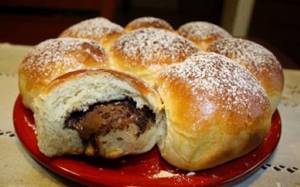
This design option is convenient for making buns at home.
What ingredients will you need?
In the set of products for decorating Brioche with chocolate filling you will need:
- soft (not melted) butter with a fat content of at least 82% - 300 g;
- baking flour – 400-450 g;
- egg fresh for no more than 3 days and large in size - 3 pcs.;
- warm milk with a fat content of 3.2% – 80 ml;
- yeast. You can use granulated ones - 10 g;
- granulated sugar – 50 g;
- warm filtered water – 80 ml;
- fine salt – 2-3 g;
- milk or dark chocolate without additives – 150 g.
To coat the buns, you need to prepare an egg, beaten with 15 ml of water.
Step-by-step cooking process
The process for creating French chocolate filled buns is as follows:
- Pour water and milk into a large bowl, and add granulated sugar and yeast. Mix the ingredients and leave the resulting mixture for approximately 10 minutes so that the yeast is “activated”.
- Next, add the pre-sifted flour and salt into the bowl with the yeast mixture. Mix the mixture until there is no dry flour left in the bowl.
- After this, you need to add eggs one by one into the resulting mass. First you need to add one egg and mix the products until the egg is completely mixed with all the ingredients. Similarly, you need to introduce the second and then the third egg.
- After adding all the eggs, the dough needs to be mixed until it forms a ball.
- Then you need to cut the butter into small pieces.
- Add each piece of butter into the dough in the same way as eggs. That is, until one piece of butter has completely “dissolved” in the dough, the next piece of butter cannot be added. This point may take about 15-20 minutes.
- The finished dough should be very plastic and not stick to your hands.
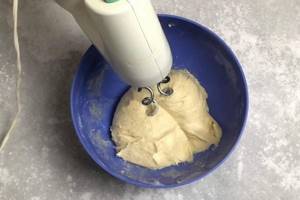
- Next, the dough should be placed in a deep container and covered with cling film.
- Leave the dough warm for approximately 60 minutes. The dough should have time to double in size.
- Then you need to knead the dough thoroughly to remove all air bubbles.
- Cover the bowl with the dough again with cling film.
- Place the dough in the refrigerator for about 2 hours. At the same time, every 20-30 minutes the dough must be kneaded to remove any remaining bubbles.
- After 2 hours the dough should “stop” and stop rising.
- After this, the bowl should be properly sealed with cling film and the dough should be left in the refrigerator for approximately 8-10 hours. Due to prolonged cooling, these manipulations are recommended to be performed in the evening.
- After the specified time, you need to grease the baking dish with oil. It is recommended to bake buns with chocolate filling in a muffin tin.
- Next, you need to remove the dough from the refrigerator and divide it into approximately 12 equal parts.
- Form each piece of dough into a ball.
- Then you need to flatten the dough ball and place 1-2 pieces of chocolate in the center.
- Seal the edges of the dough well (otherwise the chocolate will leak out during baking and will be bitter) and roll the dough and filling into a ball.
- Brush each ball with beaten egg and place in prepared muffin tin.
- Cover the pan with cling film and leave in a warm place for about 60-90 minutes.
- French buns should be baked at 180 degrees for about 25-30 minutes.
After cooking, the products should be covered with a clean towel and allowed to cool in the mold.
Mix
Turn the mixer on low speed and gradually increase it to medium. Knead the dough for 15 minutes until it forms a sticky ball. Then cover the dough with cling film and let it harden in a dark, warm place for 1 hour.
Task for children: after kneading, let your child feel the dough. Ask the children if they would like to help you seal it in film.

Make the filling. Mix brown sugar and cinnamon evenly.
Brioche buns recipe for burgers
Brioche buns (a homemade recipe that can be used to decorate burger buns) are less fluffy due to changes in the cooking process.
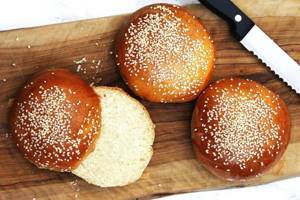
Brioche buns, recipe for burgers.
Preparation next.
What ingredients will you need?
To create Brioche burger buns you will need:
- baking flour. The product must be sifted about 3 times in advance - 420 g;
- butter with a mass fraction of fat from 82% - 60 g;
- granulated yeast – 8 g;
- warm milk with a fat content of 3.2% - 60 ml;
- large egg. The freshness of the product should not be more than 5 days - 1 pc.;
- powdered sugar – 40 g;
- warm filtered/bottled water – 240 ml.
You can use white sesame seeds to sprinkle the buns.
Step-by-step cooking process
The design algorithm for brioche buns for burgers includes the following steps:
- Mix water, milk, powdered sugar in a deep bowl. Mix the ingredients until the powdered sugar dissolves.
- Next, yeast should be added to the resulting solution. Dissolve them and leave the resulting mixture in a warm place for approximately 10 minutes so that the yeast wakes up.
- Then you need to beat the egg in a separate bowl and add it to the yeast water.
- After this, you need to add flour in parts into a common bowl and knead the dough.
- Then roll out the dough into a small layer and place a piece of soft butter in the center.
- Knead the dough until the butter is evenly distributed. On average it takes about 10 minutes.
- Place the dough in a bowl greased with vegetable oil and cover with cling film.
- Leave the dough in a warm place for approximately 2 hours.
- Next you need to preheat the oven. The temperature should be set to 200 degrees.
- Then you need to form the dough into balls approximately the size of a tennis ball.
- Place the dough balls on a baking sheet coated with oil and sprinkle each piece with sesame seeds (sesame is an optional ingredient).
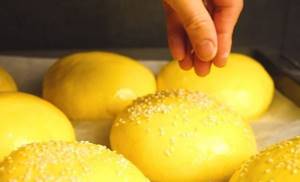
- Bake the buns for about 15 minutes.
It is recommended to leave the finished buns on the baking sheet until completely cooled. To prevent the products from becoming windy, they should be covered with a clean towel.
Dough recipe
The ingredients needed for brioche buns are:
- 1/4 cup all-purpose flour;
- 1/2 glass of water;
- 2 tablespoons white granulated sugar;
- half a teaspoon of active yeast;
- 1/3 cup warm milk;
- 3 cups all-purpose flour;
- 1/4 cup white granulated sugar;
- 1/2 teaspoon salt;
- 2 tablespoons softened unsalted butter;
- 1 egg + 1 yolk at room temperature;
- 1/4 cup warm milk;
- 1 cup brown sugar;
- 2 tablespoons ground cinnamon.
Next, take the ingredients for the cream cheese frosting:
February 22-27 Week of the Publican and Pharisee: why on these days they prepare for fasting
Not only an actor, but also an artist: what will we remember Andrei Myagkov
“How similar they are”: Yulia Menshova showed what her son was like 23 years ago
- 1/2 package cream cheese (softened to room temperature);
- 4 tablespoons unsalted butter (it needs to be softened);
- 2 teaspoons pure vanilla extract;
- 1-2 cups powdered sugar (depending on desired sweetness and consistency);
- 2 tablespoons of warm milk.
Brioche buns with cottage cheese
When cottage cheese is added to the dough, the texture of the buns does not change, but the nutritional properties of the finished product increase. If desired, the finished bun can be filled with a variety of fillings using a culinary syringe.
What ingredients will you need?
To decorate curd brioche you need:
- cottage cheese. A product with a fat content of 9% should be used. In this case, it is desirable that there are no large pieces in the cottage cheese - 200 g;
- flour. You should use a premium product and sifted - 400 g;
- granulated yeast – 12 g;
- large fresh egg - 1 pc.;
- warm bottled/filtered water – 100 ml;
- powdered sugar with added vanillin (vanillin will mask the sour smell of cottage cheese) – 50 g;
- baking soda – 3 g.
You can add about 50 g of steamed and washed seedless raisins to the dough.
Step-by-step cooking process
The stages of creating curd Brioche are as follows:
- Dissolve yeast and powdered sugar in warm water. Leave the contents warm for about 10-15 minutes for the yeast to “activate”.
- During this time, rub the cottage cheese through a sieve so that the ingredient acquires a uniform texture.
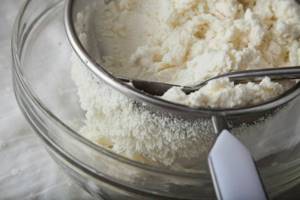
- Add the egg to the cottage cheese and mix the ingredients well.
- Pour the contents from point 1 into the curd mass, add soda and mix the products thoroughly.
- Then you need to add flour into the resulting mass in parts.
- Knead the dough by hand for at least 10 minutes. The dough should be pliable. If the recipe includes raisins, they should be added at this stage. Knead the dough with the raisins until the raisins are evenly distributed. At the same time, there is no need to knead the dough much, otherwise the integrity of the raisins may be damaged.
- The finished dough should be placed in a deep container, covered with cling film and left to “ripen” for approximately 2 hours.
- After the time has passed, you need to tear off small pieces of the dough with your hands and form them into balls (there is no need to roll out the dough with a rolling pin, as this will cause the products to lose their fluffiness).
- Place the dough balls on a baking sheet coated with oil.
- Brioche needs to be baked at 170-180 degrees for approximately 20-25 minutes.
Before serving, the buns can be sprinkled with powdered sugar or chocolate chips.
Useful tips and tricks
Brioche buns, the recipe for which can be supplemented at home with various auxiliary ingredients, will be obtained with an airy texture if the following conditions are observed during the process of kneading the dough and baking the products.
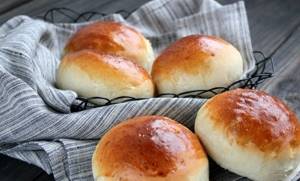
Subtleties of design of French Brioche buns:
| Basic recommendations | Notes |
| All ingredients for the dough must be warm | If the food is cold, the yeast will not activate. In this case, not only the liquid, oil or eggs should be warm, but also the flour. |
| Butter for dough must be used only fresh and with a fat content of at least 82% | The fresher the oil, the fluffier and more aromatic the finished products will be. If the butter has a lower fat content, the buns will not have the desired taste and texture. |
| The butter should be softened in a warm place (do not melt in a microwave or steam bath) | If you melt the butter, the dough in the finished product will not be oily, fluffy, and the creamy taste will be weakly expressed. |
| There should be no less butter than flour in the recipe. | If you reduce the amount of the ingredient, the buns will not differ from classic baked goods. |
| Knead the finished dough for at least 15 minutes | The longer the kneading, the more evenly the butter will be distributed in the dough. |
| When kneading, there should be no large bubbles in the dough | If there are large air bubbles, the buns may not come out with the desired texture. |
| After kneading, the dough needs to be refrigerated. | By keeping the dough in the refrigerator, the fermentation process of the yeast slows down and the ingredients combine better. |
| When in the refrigerator, the dough must be placed in a food bag | If the dough is left open, it will not only dry out, but also absorb foreign odors. |
| After cold, the dough should be immediately poured into prepared forms. | After cooling, the dough begins to rise quickly. And if the dough is allowed to rise initially in a container, and then in a mold, then it is impossible to achieve the desired texture in the finished product. |
| Flour for dough must be sifted at least 5 times before use. | The better the ingredient is sifted, the more magnificent the products will be. Additionally, all debris will be removed from the flour. |
| It is recommended to use live yeast for dough | Only fresh and live yeast will give your buns an airy texture. |
| Brush the buns with beaten egg before baking. | A beaten egg will give the finished products gloss and an especially crispy thin crust. |
| The finished dough can be frozen | To prevent the dough from losing its fluffiness after defrosting, it should be defrosted for at least 8 hours in the refrigerator. |
After baking, Brioche buns need to be cooled in the pan (in which they were baked), regardless of the recipe. If the products are removed immediately, they may settle and the airy texture will be lost. These conditions should especially be observed when preparing buns at home.
